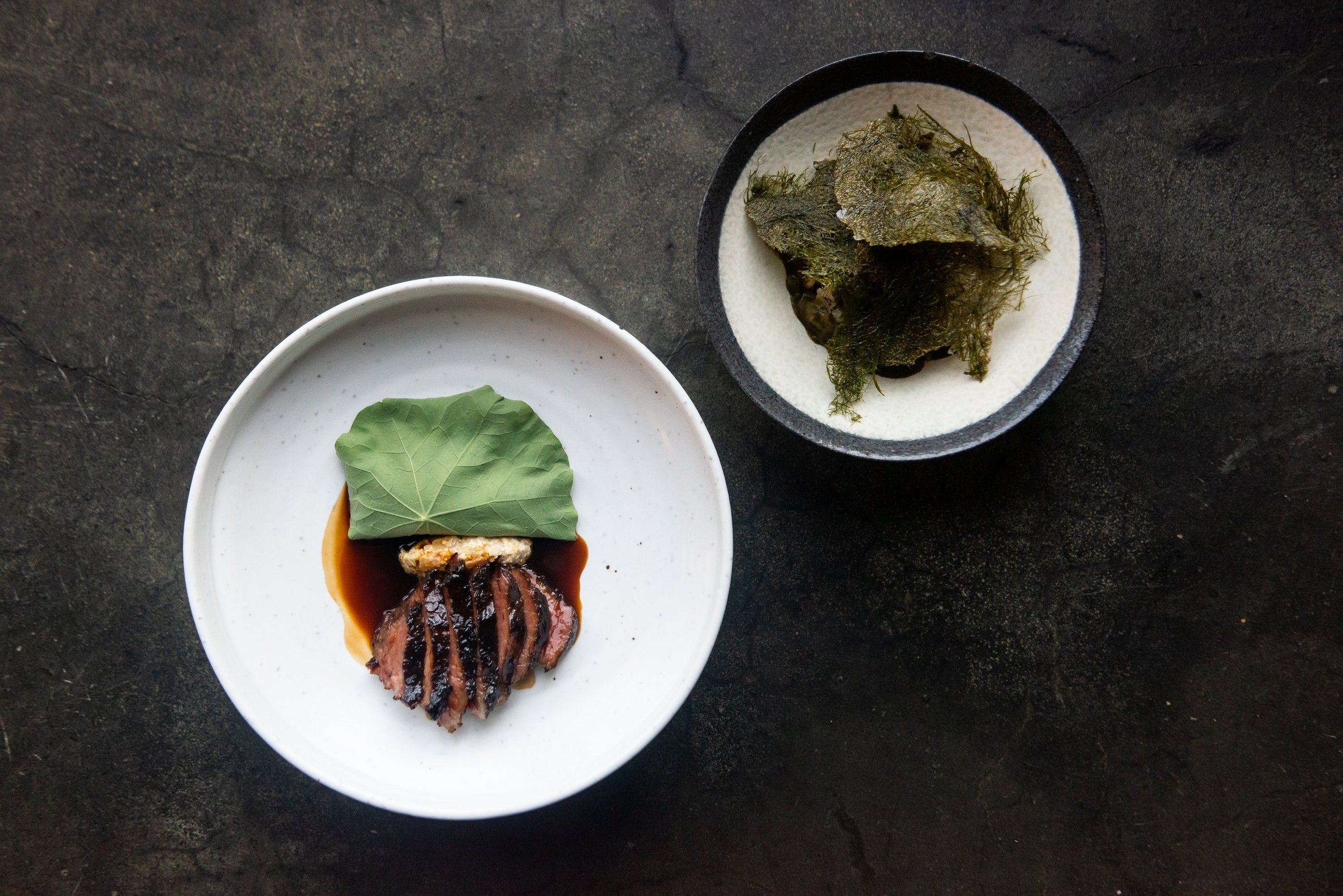Against-the-Grain Galbi
Chef Kwang Uh reconstructs a familiar Korean dish at Baroo.
(1) Sweet Soy-Marinated Brandt Short Rib, Burdock Jus, White Kimchi, Perilla Seed, Pickled Lotus Root, Mustard Shoots (2) Rice, Korean Wild Greens, Pickled Watermelon Radish, Sunchoke, XO Sauce, Gamtae Chip
For Chef Kwang Uh, Baroo is not only a home for culinary experimentation, but also an amalgamation of his time spent cooking around the world.
Uh and his wife, Mina Park, opened the Arts District restaurant in September 2023 after a successful run of their pop-up, Baroo Canteen. Uh’s modern Korean tasting menu plays with traditional Korean dishes and ingredients, pulling from techniques he learned at renowned restaurants like Noma, Spain’s Quique Dacosta, and Piazza Duomo in Italy. One of the chef’s menu staples is his beef short rib. “I got the idea to remake the concept of Korean barbecue.” Uh takes a different approach by weaving together familiar flavors, components, and formats of Korean cuisine through the lens of his layered experiences. “My inspiration comes from food and anthropology—understanding the origins of a food and knowing it deeply. It’s all connected.”
Short Rib
For the centerpiece of the dish, Uh first whips up a galbi marinade of soy sauce, sesame, sake, mirin, and a housemade Asian pear syrup. The short rib is marinated 24 hours, cooked sous vide in the marinade, and left to rest in the liquid for an extra six to eight hours for maximum flavor. “Growing up, we had galbi-jjim with different side dishes, like burdock.” Uh finds a different way to incorporate the root by infusing the burdock into the beef jus with garlic, ginger, chile, and medicinal Korean herbs that he then cooks down to a thick, glossy sauce. “Not everyone likes burdock but it's my favorite.” For pick-up, the short rib is then grilled to a nice char and plated with the earthy, sweet, and savory jus.
White Kimchi
Another mainstay of Korean cuisine, Uh serves kimchi alongside the short rib, but opts for a more mild white kimchi. “If you check a Korean family’s pantry, perilla is a staple. But, [kimchi and perilla powder] together are not really common.” The kimchi is stir fried with perilla seed powder, finely chopped, and added to the center of the dish for a pop of acid that cuts through the rich sauce. “It's a familiar flavor for Koreans, but still different.”
Sweet Soy-Marinated Brandt Short Rib, Burdock Jus, White Kimchi, Perilla Seed, Pickled Lotus Root, Mustard Shoots
Rice, Korean Wild Greens, Pickled Watermelon Radish, Sunchoke, XO Sauce, Gamtae Chip
Ssam
Uh serves peppery nasturtium, butterfly sorrel, and oyster leaf alongside the short rib. “Usually, people like to use just oyster leaf for the ssam, but I like to use butterfly sorrel for the sourness.”
Rice
“Rice—it’s an integral part. You can’t run away from it!” Uh’s rice, a customer favorite, incorporates three types of wild Korean greens, which he rotates out depending on the season. To accompany the rice, he makes an XO sauce, mixing together “the techniques of China and Korea.” To introduce more Korean flavors into the sauce, he adds in gochujang and doenjang. “[Doenjang] is pretty salty. We Koreans use it with rice.” The decadent, umami-fueled sauce is spooned over the rice, which is then covered with a gamtae chip. Uh brushes seaweed with rice flour paste, dehydrates it, and then fries it for a hit of crunch and sea-forward flavor. At the table, guests are encouraged to mix the toppings into the rice to capture the flavors in every bite.
Pickled Vegetables
In line with a standard Korean meal, Uh includes a banchan of pickled vegetables—watermelon radish, lotus root, and sunchoke in this case. The pickled watermelon radish, however, is fermented in a rice vinegar infused with rose petals and rose water for a gentle floral touch. And instead of pairing the banchan on the side, Uh plates them over the rice for another layer of texture and acid.








